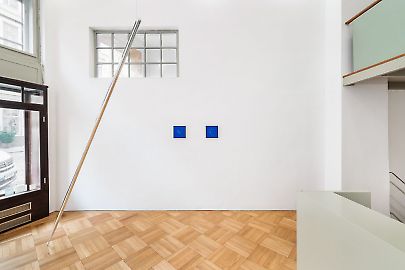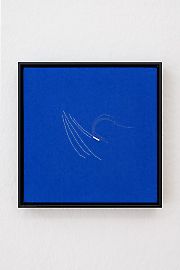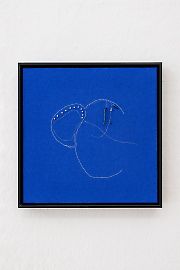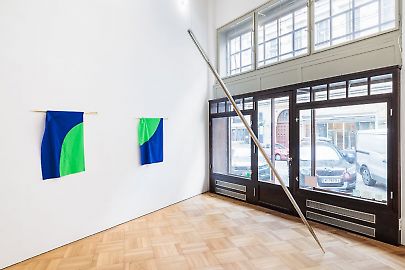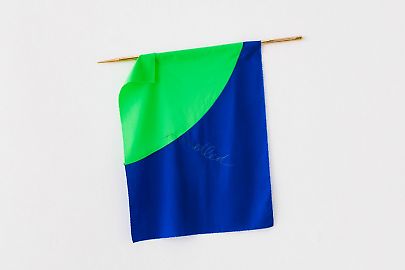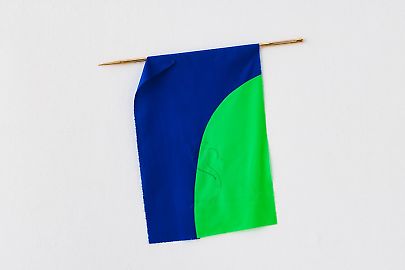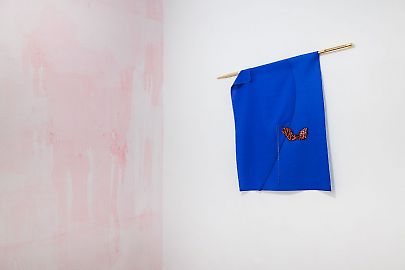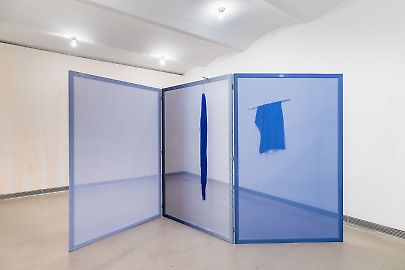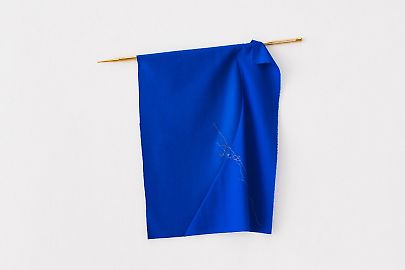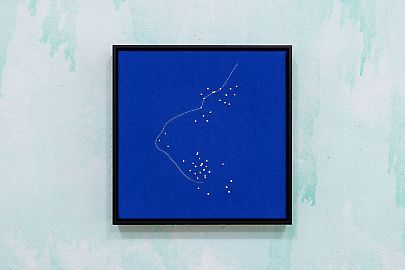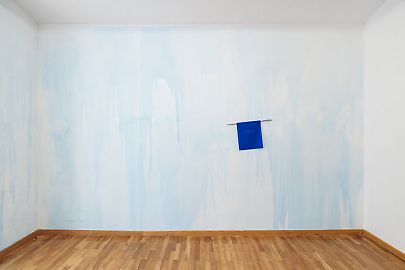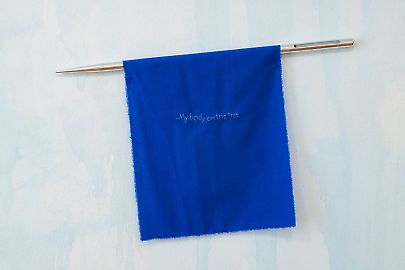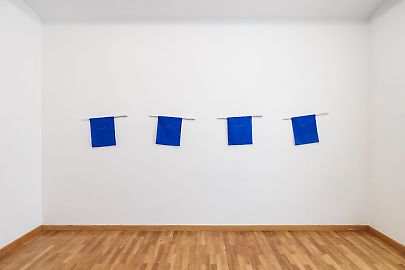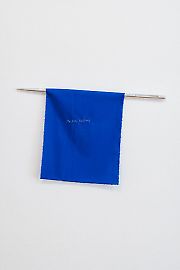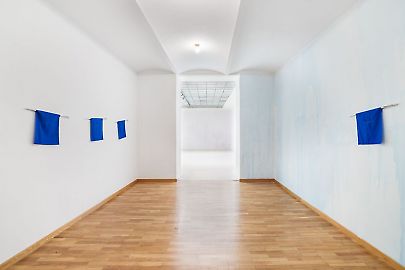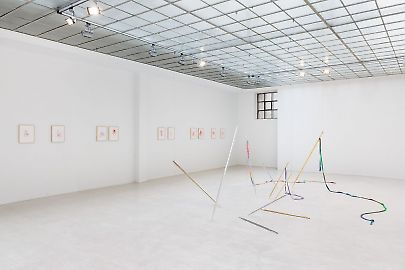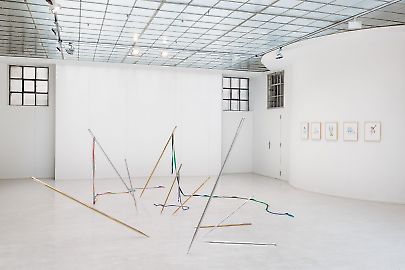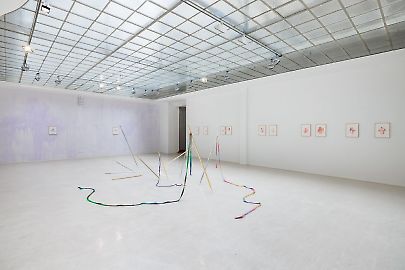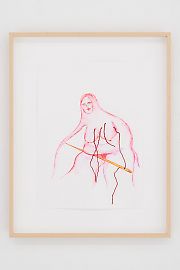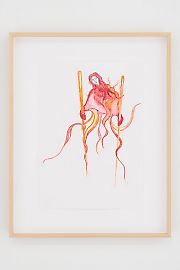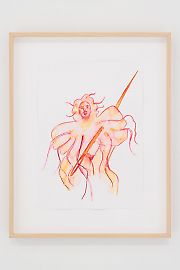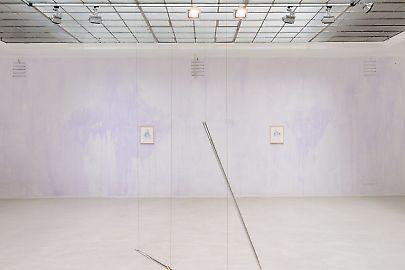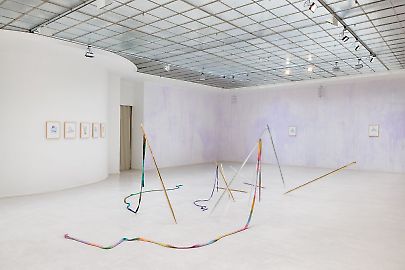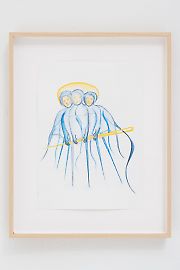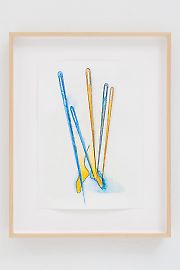Katrina Daschner -- The Borrowed Eye of a Needle
Katrina Daschner’s multimedia work, which encompasses film, performance, painting, sculptural objects, drawing and installation, as well as community practice, is performative at its core. It addresses and performs modes of being and non-being that arise from questions of queer (in)visibility, the liberation of the body from heteronormative codes, and the joyfulness found in acts of solidarity and resistance. While rooted in the self and the autobiographical, resistance for Daschner is always collective. The longing for perceptibility, the desire to deeply feel all aspects of our lives is visually manifested in the use of different (textile) materials through embroidery, sewing, crochet and knitting techniques, in bright, bold colours, shining and tactile surfaces and in a close dialogue with the space. Whether in her films or when working with exhibition formats, Daschner approaches the space as a stage, creating environments, inhabited with her lively, mutable characters. For this exhibition at Georg Kargl Fine Arts, Daschner decided to forego cinematic works in favour of sculptural and textile bodies of work (all works 2023–2024) in an environment of colourful, watery coloured wall-paintings, corresponding with her watercolour drawings. Walking through the spaces, one can notice the rainbow colours of the LGBTIQ+ community.
Textile, a material often more reminiscent of women’s craft than an artistic medium – associated with virtuous industriousness and historically used to constrain women’s imaginations and ambitions – has gained recognition from the art world over the past decade. In “A Survey on the Significance of Textiles in Contemporary Thought and Praxis,” published in 2014, Rike Frank and Sabeth Buchmann note that textiles have been the focus of many research projects and major exhibitions in the years leading up to the publication of their article.[1] Ten years later, exhibitions dedicated to the use of textiles as an artistic medium in (contemporary) art, offering insights into regional forms of expression, experience and social practice, mainly by women artists, are still increasingly present. “I start somewhere and it expands instinctively from there,” says Daschner of a certain sense of freedom she finds in embroidery, which has been a constant presence in her work since the very beginning of her artistic career in the mid 90s, also as an additional, abstract way of imagining her filmic works (the so-called “embroidered storyboards”).[2] The needle is her tool, the “handiest pen to write down my inner thoughts” – with it, through the rhythmic, intimate acts of stitching, she reclaims space and her own narrative, which expands and grows. Hanging on the walls, on view are filigrane embroidery works on blue and green screen fabric, reminiscing her filmic practice, which combine coloured threads with tiny, shiny beads (Water Beings (blue series), 2024); embroideries joint with golden brass needle objects, 100 x 100 cm in size (Heavy Needles, 2024); and golden brass needle objects, 70 cm in size, with crochets (Silver/Golden Eggs on Golden Needle, 2014/2024). Very personal to Daschner in the exhibition is the embroidered series, My Body, 2024. Here, her embroidered handwriting reads: “My body on the tree / My body fragmenting / My body breathing / My body untangling / My body unfolds.”
In her new sculptural works, Daschner’s needle is no longer a hidden tool of the textile practices – it becomes a body in itself, a hundred, a thousand times its life-size, larger than life, a Needle with a capital letter. This small, slender instrument with a pointed end, typically with an eye at one end for threading, used for sewing by hand, now weights[3]– made of brass, shining in a silver or golden tone, it tries to fight against the laws of gravity, suspended in the air in the first and the last rooms of the gallery, sometimes adorned with a colourful knitted yarn. In defining what is the “subject” as opposed to its counterpart, the “object”, Hegel refers to Aristotle, for whom a subject is that which moves by itself. For Hegel, to move by itself is a work of self-reflection; the object is characterised above all by its immobility. Reflecting its own otherness and difference, the subject moves through time, while the object occupies space; a subject can therefore only exist in the process of subjectivation, of constant becoming. In the context of all the varied subjects that have inhabited Daschner’s diverse work – from her early collages and self-stagings to performances and films – the Amazon Needles (2023/24) become swords and weapons, the self-sufficient selves that can, so the artist, “borrow their eyes” to the audience. They are comrades, sisters. Transformation and metamorphosis are key components of storytelling the histories of the oppressed. Through storytelling, the marginalised – women, LGBTIQ+ communities – have historically conveyed the ways in which they have transformed their circumstances, challenged injustice and asserted their agency through individual acts and collective organization and mobilization. The symbolic and metaphorical dimensions of narration are crucial in contexts where marginalised voices are often silenced or overlooked; storytelling becomes an act of preservation and resistance.
Storytelling is a vital part of Katrina Daschner's artistic practice. She creates narratives that redefine notions of gender categories, (physical) strength and social agency. The series of watercolours (all 2024) exhibited in the last room of the gallery, presents portraits of women as imaginary animal beings (as jellyfish, sometimes insects), as animalistic women, wild and wise women, tender and vulnerable, doubtful, hesitant and ambivalent in their choices, saints and sinners, holding needles as swords to protect themselves and their community, to form a resistant collective body and to carry on. A needle can hurt and heal; with a needle you can hurt and you can heal; it carries within itself the possibility of retelling, of rewriting histories.
Hana Ostan Ožbolt
[1] The survey was first published in Texte Zur Kunst (Issue No. 94, May 2014, available also online at https://www.textezurkunst.de/en/94/survey-significance-of-textiles/) and resulted in a book Texile Theorien der Moderne. Alois Riegl in der Kunstkritik (b-books, 2015).
[2] All quotations from the artist in this text are based on a personal conversation with Katrina Daschner on February 25, 2024.
[3] “The body is weight. Laws of gravity involve bodies in space. But first and foremost, the body itself weighs: it is sunk into itself (…)” Jean Luc Nancy, Corpus, Fordham University Press, 2008, p. 7.


